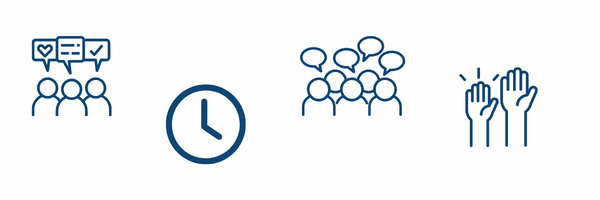
Check-ins, openers, and icebreakers play a critical role in a meeting’s success.
When weighing how to spend precious time, sometimes leaders cut them to squeeze “work” out of every minute of an agenda. However, prioritizing efficiency over time spent connecting and understanding one another can ultimately result in less effective meetings.
When you bring together a group of individuals “the work” of the meeting includes a human element that needs attention.
While it may seem like you only need to focus on completing that day’s task, creating space for meaningful connection can tangibly improve a group’s quality of work. Tapping into the different experiences, contributions, needs and perspectives of participants also creates the building blocks for longer term effectiveness and satisfaction. This can be especially true for teams with people from a wider variety of backgrounds.
And yet, I still routinely attend meetings that begin by diving right into an agenda topic. I find myself looking around the room to identify who is there and looking for context clues about the group dynamics in relation to the meeting purpose by people’s expressions and body language. (Mindreading is not a reliable way to know what is happening!) The context is even harder to discern in online meetings.
Attention to the human element is especially important when working in partnership within and across organizations, where increased understanding and trust are important. Introductions and everyone’s early participation can level the playing field for new people and those with less positional authority – knowing who is in the room and being familiar with who is speaking can decrease the intimidation factor of participating.
You can create an entryway to better work and to something greater by thoughtfully using openers, check-ins, and icebreakers. The result can be as simple as useful information that improves your project, as helpful as increased energy, and momentum, and as profound as a deep insight into life and the humanity of others.
The options are infinite, and the key is matching your choice of opener to the scale of your meeting’s purpose, number of participants, and time. Here are some examples:
- How to focus time in a 60 min meeting? When the planning group for an upcoming convening logs in to review the convening agenda, the leader uses an online tool like Padlet for two opening questions. They ask: what part of the program are you most excited about? And: where do you have concerns? The answers inform the meeting’s focus.
- How to create energy and connection with a large group? A group of 40 that works separately on the same strategy are evaluating their work over the past year in a day-long, in-person meeting. They begin with two short (6 min each) rounds of conversation in groups of three. The questions are: “share something about your weekend” and “share one question you hope to answer today”. Afterwards, the room is buzzing with sound and energy. The facilitator gathers some responses from the whole group about their questions and everyone in the room deepen their understanding of the day’s work.
- How to create connections and build a team through a reoccurring meeting? The 6-person group rotates facilitation, and each meeting starts with an opener of the facilitator’s choice. Sometimes it’s more business (what’s your top priority this week), personal (what’s your favorite__), or fun (trivia, game, etc.). Over time, the mix builds personal and professional connections that allow them to coordinate and communicate better, especially in a crunch.
- Creating connection in a large Zoom meeting? There are dozens of participants that cannot fit on one Zoom screen all focused on conservation efforts in networks in a 4-state region. The facilitator puts the group in three-person breakout groups for 6-minutes asking folks to share a recent success. The responses are collected using an online tool like Mentimeter to have a shared sense of colleagues’ work.
If the various generic ice breaker resources you find online don’t quite fit your purpose, time, and audience, use ICL’s Guide to Check-ins, Openers, and Icebreakers to design the meeting opener that works for your group!
Other useful resources:
- Padlet – collaborative web platform that uses virtual bulletin boards
- Mentimeter – virtual tool for engaging and interacting with audiences in real time
- Liberating Structures – 1-2-4 All Exercise
